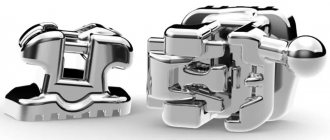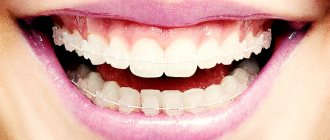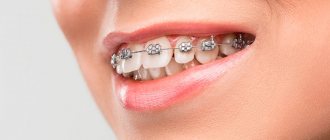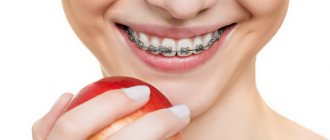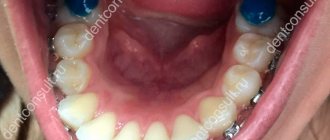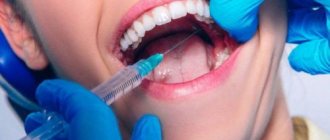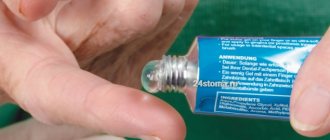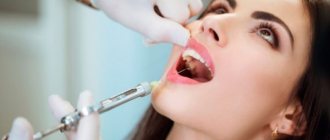Excursion into history | Ligature and self-ligating constructions | Biomechanics of tooth movement | System installation | Stages of treatment | Lingual and vestibular structures
Braces are locks fixed to the teeth with a groove and “wings”. The principle of operation of the system is the ability of the orthodontic arch to return to its original position. The straightening archwire puts pressure on the braces, causing the teeth to move. Fixed retainers and aligners stabilize the results obtained at the final stage of treatment.
The material was verified by Anna Rimkevich, senior product manager at Ormco Russia.
The basis of bite correction is the mechanism of action of weak forces and the movement of teeth in accordance with the bends and shape of the arch. The metal arch has “shape memory”: it straightens, pulls the braces along with it and moves the teeth in the desired direction. The formation and destruction of bone tissue is part of the natural process of tooth movement. The principle of operation of braces allows you to achieve the goal of orthodontic treatment - to create the best balance of occlusion, facial aesthetics and dentition.
Damon Clear with orthodontic arch
Excursion into history
At the beginning of the 20th century, the American doctor Edward Engle created the first prototype of the braces system and called it the Engle apparatus. Angle's apparatus consisted of an elastic stainless steel arc and ligature elements. The arc was tightly fixed in the tubes. The tubes were soldered to orthodontic rings placed on the first molars. Each tooth was tied to an arch curved in the shape of the dentition with a ligature wire.
Subsequently, the scientist significantly changed the original design and developed the edgewise technique. Orthodontic locks, edgewise, were a rectangular piece with a groove. An arc was inserted into the groove and the lock was locked with a pin. Subsequently, the design of braces was modified: orthodontic arches with a square and rectangular cross-section profile, with sharp and rounded edges, appeared.
Later, the edgewise technique was further modified by doctors. Thanks to the active development of orthodontics in the 20th century, the modern operating principle of braces was formed. Today, the doctor is offered various options for torque and angulation. Torque (or inclination) is the deviation of a tooth from its axis in the vestibulo-oral direction. Angulation is the deviation of the tooth in the mesio-distal direction. Taking into account torque and angulation allows, based on a specific clinical case, to individually select the optimal brace option for each tooth.
Content:
* For detailed information about the conditions of the promotion, please contact the clinic administrator.
Braces are a dental structure used to straighten teeth and correct malocclusion. Braces are a system of mini-locks (brackets) connected to each other using an arc that holds a given shape. Braces are a one-piece design (system), which is often called a bracket system. You can hear both of these names equally often.
Installing braces is an effective way to treat malocclusion and straighten crooked teeth, which can be used in both adults and children.
Construction of braces: comparison of non-ligating and self-ligating structures
There are ligature and self-ligating devices. The first includes traditional designs: the arc is fixed in the groove using elastic or wire ligatures. Example: Mini Diamond, Inspire Ice, Orthos devices. Ligature systems are characterized by a long treatment period - from one to three years, depending on the complexity of the clinical case, lengthy adaptation and labor-intensive hygienic care. Activate the device: replace arches and ligatures, it is necessary on average once a month, and sometimes more often.
traditional construction with ligatures
ligature Mini Diamond
The design of self-ligating braces has a fundamental difference: the system works without ligatures. Consists of a groove and a closing lid. The orthodontic arch slides in the groove. Ligature-free designs provide a reduction in treatment time compared to ligature devices by an average of 7 months. Less painful during the adaptation stage and easier from the point of view of oral hygiene. They turn out to be the option of choice in many clinical cases. The entire line of Damon System braces are self-ligating.
self-ligating Damon Q2
How does a braces system without ligatures work? The principle of operation of non-ligation devices is divided into passive and active self-ligation. With the passive type of fixation, the arc moves freely in the groove. The cover holds the arc and does not put pressure on it. Example: Damon Q, Damon Clear. With the active type of self-ligation, the clip presses on the arch and moves it to the base of the groove. Activation of self-ligating systems is carried out once every 2-3 months.
system without ligatures
Damon Clear and Q on typodont
Braces are made from various materials. Ligature and self-ligating structures are made of metal, transparent polycrystalline aluminum (ceramics), plastic and artificially grown sapphire. Metal braces, for example, Damon Q and Damon 3 MX, are the most durable. The Damon Clear2 ceramic and sapphire Inspire Ice models have the best aesthetic characteristics.
metal Damon Q2
ceramic Damon Clear
The orthodontist and the patient jointly overcome the path to high aesthetic smiles and a healthy dental system. Regardless of the type of braces and manufacturing material, the combination of the orthodontist’s professionalism with a high degree of patient responsibility allows one to achieve stable results in the treatment of malocclusions.
Biomechanics of tooth movement
To understand how braces work, let’s look at the biological and physiological processes that occur during tooth movement. The teeth are located in the alveoli - natural depressions in the jaw bones of the skull. The root of each tooth is surrounded by periodontal fibers that hold the tooth in the socket. The fibers also perform a shock-absorbing function: they allow the tooth to make micro-movements in all directions. After fixing the bracket and installing the arch, force begins to act on the root of the tooth. To move teeth slowly and less painfully, a weak and prolonged force is applied.
Due to the movement of the tooth root, there is a need to free up space in the alveolus. To do this, osteoclasts begin to destroy the bone where the root touches the alveolar wall. Osteoclasts are special cells that remove bone tissue. On the opposite side, osteoblasts produce new bone to fill the vacated space. Under the influence of osteoclasts and osteoblasts, the balance of formation and destruction of bone tissue ensures the progressive movement of teeth.
Installation of braces
A general understanding of how dental braces work, the design and installation process of the system is important for everyone. There are two installation options: direct and indirect method.
The direct method involves manually installing and positioning each bracket on a tooth directly in the patient’s mouth. Fixation is carried out on a light-curing material. The indirect method involves positioning the system on a plaster model. The braces are transferred from the model to the mouthguard. The mouthguard is formed individually for each patient. Next, glue is applied, the mouthguard is put on the teeth, and the braces are fixed in a predetermined position for each jaw in turn.
Ligature systems
The name reflects the very principle of operation of the bracket system: the use of auxiliary elements (ligatures) to attach a metal arch to the bracket-lock. There are two types of ligatures:
- made of wire;
- made of elastic.
Rubber ligatures can simultaneously act as a decorative element. They are produced in a variety of colors, and there is no problem in choosing these elements of the braces system to match your eye color or just your favorite shade.
Ligature braces are a classic of orthodontics. Here are the materials they are made from:
- metal - the most budget and common type;
- ceramic - the peculiarity is that you can match the color of your teeth, and they will be almost invisible;
- sapphire - made of artificial sapphire, considered the most aesthetic, it is easier to care for than metal or ceramics, but they are the most expensive.
The peculiarity of ligature braces is that during the correction process, the wire arch or elastic bands gradually stretch, and you need to periodically visit the orthodontist to replace the ligatures.
Stages of treatment
The first stage is preparation for orthodontic treatment. Preparation includes x-ray diagnostics, sanitation of the oral cavity and removal of the required number of teeth.
The second stage involves fixing the structure. An initial thin arch with a round cross-section profile is installed. Further in the treatment process, the doctor changes the arcs from a smaller cross-sectional diameter to a larger one. At the final stages, rectangular rigid arches are used.
On average, it is necessary to visit a doctor from once a month when treating with ligature models to once every 2-2.5 months when treating with self-ligating systems. At the end of the second stage of treatment, the doctor removes the braces using enamel-safe forceps. The remaining adhesive is removed from the surface of the teeth with a low-abrasive bur, and the tooth is polished with a brush using a polishing paste.
The third stage is the retention period. The results of orthodontic treatment are stabilized with the help of permanent retainers and aligners.
The duration of treatment depends on the complexity of the anomaly being corrected, the individual anatomical characteristics of the patient and the professionalism of the orthodontist. The speed of tooth movement is influenced by the design of the brace: self-ligating systems can provide faster results in 1-2 years. Treatment with ligature models lasts on average 2 to 3 years.
Some dental anomalies are corrected using removable hard aligners. When treated with aligners, the patient is given a set of several rigid aligners that differ in shape. The patient changes the aligners independently every two weeks. Once every month and a half, the patient visits the orthodontist to assess the progress of treatment. Mouthguards are worn constantly: the device is removed only when eating and brushing teeth.
Wearing elastics
In many cases, the doctor prescribes so-called elastics - elastic rings that the patient puts on the hooks of braces. Elastics help to move teeth in a directional manner and change the relationship of the jaws. We recommend carefully following the orthodontist's recommendations for wearing elastics, because... this element plays a vital role and contributes to the speedy completion of treatment.
Your doctor may prescribe wearing elastics for 12 or 24 hours a day. Elastics should only be removed when brushing your teeth and eating.
Comparison of lingual and vestibular constructions
Based on their location in the dental cavity, they are divided into lingual and vestibular systems. The vestibular position on the outer side of the dentition is classic and is used in the vast majority of cases.
Vestibular Mini Diamond
Lingual appliances are installed by patients with the highest aesthetic requirements. Adaptation to internal systems is more difficult compared to vestibular structures. The principle of operation of lingual and vestibular braces is not fundamentally different: in both cases, the arch is straightened and exerts a force on the braces, leading to the movement of teeth. If there is excessive crowding, the use of a lingual system is not recommended. The duration of treatment on the lingual structure is slightly longer than on the vestibular one. The patient sometimes experiences additional discomfort due to the interaction of the tongue with the brace system.
lingual braces STb
Diagnostics
When making a diagnosis, the dentist performs an examination and prescribes additional tests. After clarifying the violations, the patient is offered several designs to wear. Pathologies are better eliminated with metal corrective structures.
Braces correct the bite and straighten the teeth. They are much more comfortable to wear. Ceramic or sapphire braces are more expensive. Ceramics are the leaders in such systems because they are completely invisible on the teeth.
For patients who want to completely hide the wearing of braces, experts recommend installing lingual systems. Fixation is performed on the inside of the teeth. The doctor will be able to select the optimal system only if he studies the structure of the patient’s jaws. For these purposes, the following studies are prescribed:
- orthopantomogram (panorama of 2 rows of teeth. The image shows the structure of each tooth. The dentist can assess the condition of the maxillary joints and paranasal sinuses);
- teleroentgenogram (a photograph of a tooth from a distant angle. The ratio of the sizes of bones and soft structures is revealed. The level of inclination of the tooth and the degree of displacement are visible);
- X-ray (photographs in direct, lateral, axial projection. The upper dental arch is clearly visible, defects and anomalies of the movable jaw are visible);
- a snapshot of the elements of the dentition and face (facial asymmetry and soft tissues are analyzed);
- taking impressions of the dentition (done to make plaster models of the jaws);
- tests in the articulator (predicting the behavior of the jaws while wearing braces).
The patient may need consultations with an implantologist, therapist, orthopedist and surgeon. If the violations are serious, the procedure will take about 10 days. For small defects, a complete examination takes 2 days.
Installation of veneers
Veneers are porcelain or composite plates that replace the outer thin layer of a tooth.
Effectively correct dental discoloration, cover cracks or stains due to enamel hypoplasia. Veneers are an aesthetic solution and do not replace orthodontic treatment. Unlike veneers, braces move teeth. Treatment with braces ensures the formation of an aesthetically correct smile, restoration of the physiological bite and function of the dental system. The material is for informational purposes only and is presented for informational purposes. It does not replace consultation with an orthodontist and is not a guide to correcting dental anomalies.
Retention period
After all the teeth have been moved (and only the orthodontist decides when the treatment is completed), the braces are removed. The arches are removed, the locks are removed from the teeth, and professional dental hygiene is performed. Now it is important to keep the bite in this state for some time until the gums and teeth themselves “retain” this arrangement as natural. Retention mouth guards are used for this purpose.
These mouth guards are made individually based on a computer model of the new bite. You should wear these aligners yourself for some long time (several months, a year, only an orthodontist can call it more precisely). After the retention period, the entire complex of bite correction is completed and you enjoy your perfect and healthy smile!

